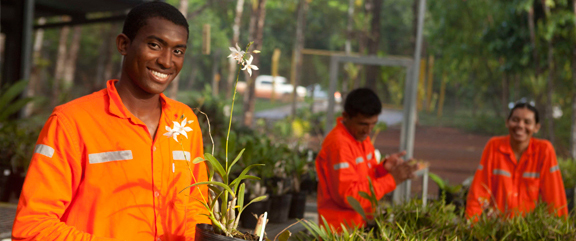Social and Environmental Performance
Aluminum companies in Brazil do not limit themselves to complying with the laws and regulations in force; they stay ahead of the game in terms of the economic, environmental and social needs of their surroundings. They restore mined-out areas, dispose of their waste in the best way possible, work constantly on reducing atmospheric emissions and the energy efficiency of their processes, and continuously broaden the scope of their actions in the community.
Some examples of socio and environmental actions of the aluminum industry.

The mining industry promotes the temporary use of the land, which it reclaims before returning it, by applying handling techniques that are fundamental to the soil after mining. Bauxite mining areas benefit from the rehabilitation process of native flora and fauna. Companies have implemented their own planting programs, with seedling production in nurseries, which aim to recover the maximum biodiversity in each region where their plants are located.
Every ton of alumina produced generates between 700 and 900 kilograms of bauxite residues. These residues are present in the form of a solid-particle alkaline pulp, and require careful disposal to prevent contamination of surface and groundwater.
The areas for disposal of this waste are waterproofed beforehand using layers of clay and PVC, and contain drainage systems in the bottom aimed at returning neutralized water to the environment. After all neutralized water has been discharged and only inert solid material is left, the areas are rehabilitated with native vegetation and undergo through frequent underground and surface monitoring.
The aluminum industry is also the seeking potential uses of bauxite residue as raw material for other activities. The residue is now used in both the cement and the ceramic industry, for producing bricks and tiles.
Technology is already in place that recycles those residues generated in the production process, both in primary aluminum and secondary production. Residues from calciners in primary aluminum plants are used in the refractory industry, while the spent pot lining from potrooms serves as raw material for the ceramic industry and raw and melting material for cement manufacturing. Carbon residues are also used as fuel for cement industry furnaces.
The production of the secondary metal generates slurry known as aluminum dross, with rich in salts and aluminum oxide and a small percentage of metallic aluminum. Reusing this slurry to extract the aluminum it contains still generates a residue. This residue can be treated, and salt can still be recovered.
Energy is the major input for the primary aluminum industry, a stage in which metal production is electro-intensive. In the remaining stages of the production chain, energy consumption is low, and can be compared to any industrial process.
In a way to make this intensive use of energy cause the least possible impact on society, the global aluminum industry is concerned with improving energy efficiency in their processes.
Another means for the aluminum industry to contribute to lower energy consumption in its processes is by increasing the share of secondary aluminum – resulting from scrap – to supply metal for the processing chain. The production of secondary aluminum requires only 5% of the power required for the smelting process for primary aluminum.
The Brazilian aluminum industry also invests in self-generation of electricity to keep their plants competitive. Currently, self-generation accounts for 42% of electricity consumed by the industry, a percentage that should reach 50% when new ongoing projects begin to operate.

In the social field, the aluminum industry undertakes corporate responsibility practices by promoting a better quality of life for its employees, together with training and professional development. Over 450 million people rely on this industry, which employs more than 200,000 workers, both directly and indirectly, and another 250,000 people engaged in recycling.
Constant appreciation of its employees and commitment to developing the communities neighboring its plants are values incorporated into the way in which this industry operates, invests in and does business. This industry fosters quality of life for its employees and the society in general, by means of initiatives and policies that are of great value to the communities where it operates.





